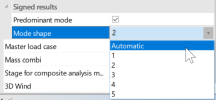Seismic load case settings
Seismic load cases have many settings. Some specific uses of them, although theoretically possible and requested by some advanced users, are not recommend for usual cases, mostly because it makes little sense from a practical point of view.
Signed results & Predominant mode
The selection of the predominant mode for signed results offers the possibility of selecting automatically the mode shape.
Because of the way the predominant mode shape is determined, it is usually not recommended to use that option for 3D models. The automatic selection of the predominant mode is performed on the basis of the value of the combined effective modal mass ratio:
That formulation disregards the fact, that the effective mass ratio should be considered in the direction of the seismic action, which is defined by direction factors X, Y and Z in the seismic load case settings. For instance, consider a structure that would have the following effective modal mass ratios for the first 3 modes:
| Mode |
|
|
|
|
| 1 | 5% | 65% | 0% | 65.2% |
| 2 | 70% | 15% | 0% | 71.6% |
| 3 | 0% | 0% | 35% | 35% |
A seismic load case using automatic predominant mode selection would always select mode #2 for result signature, regardless of the actual direction of the seismic action.
For such a structure, a seismic load case in Y direction should use mode #1.
As a consequence, automatic selection of predominant mode usually works fine for 2D models with horizontal seismic action, but is problematic for 3D models in most cases.
For 3D models, always assign the predominant mode manually.
CQC modal superposition & Multiple eigenshapes
SCIA Engineer offers 3 seismic modal superposition methods (for more details & theoretical background, see "Seismic loading: Modal superposition"):
- SRSS - Square Root of Sum of Squares
- CQC - Complete Quadratic Combination
- MAX - a variation of SRSS that gives more weight to the mode with highest contribution
SRSS and MAX methods are based on the assumption, that all mode shapes are sufficiently spaced and hence do not interfere with each other. Typically, it is commonly admitted, that modes with frequencies that have more than 10% difference can be considered as decoupled and can therefore be safely combined using SRSS or MAX modal superposition.
When modes are closely spaced (less than 10% difference between their frequencies), their interference must be taken into account. Two approaches are offered for that in SCIA Engineer:
- CQC modal superposition: modal interferences are taken into account using correlation factors used in modal superposition
- Multipe eigenshapes - Unify eigenshapes: close modes are considered as "simultaneous"
Both methods have the same purpose and should not be combined. Using them together can lead to incorrect results, more conservative than necessary.
For a correct modal superposition of closely spaced modes, use either of the following
- CQC modal superposition
- SRSS or MAX modal superposition with Unify eigenshapes option ON
Do not use CQC modal superposition with Unify eigenshapes.
It is good practice, to systematically use CQC modal superposition. However, CQC is computationally more intensive than SRSS and can increase the computation time of seismic load cases.
Mass in analysis
SCIA Engineer offers 3 options to account for a possible deficit of effective modal mass (for more details, see "Seismic loading: Mass in the seismic analysis"):
- Participating mass only: computed modes are taken into account as-is
- Missing mass in modes: the deficit of effective modal mass is compensated by increasing the modal participation factors of the computed modes
- Residual mode: the deficit of effective modal mass is compensated by the addition of a static pseudo-mode in the modal superposition
Although the second and third are conservative, it is not always necessary to use them.
According to most seismic design standards, if the cumulated effective modal mass ratio is greater or equal to 90%, no compensation of the mass deficit is required. The first option (participating mass only) can be used safely.




